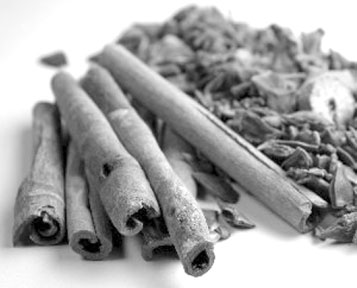 
The cinnamon charm
by Tissa Hevawitarana
Arabs have known Ceylon (then)
more than the Ceylonese had known anything about the Arabs. Long before
Marco Polo, Colombus stumbled on the rough seas in search of adventure,
the Arabs criss-crossed the red seas for brisk trade.
Their ships carried spices, silk and gold from Damascus to Sri Lanka
through India. They looked to Sri Lanka more than any other country for
black pepper, cloves, nutmeg, cinnamon, cardamom, ginger that huffed and
puffed stimulating colours and flavours into dull uninspiring European
dishes.
Arabs, Portugese, Dutch and British outdid one another in their
efforts to grab and maintain what Sri Lanka had to offer.
The stage was set for a great leap forward in the art of cooking and
good eating. Therefore, the aromatic plant known as cinnamon was picked
to be cultivated exensively in the island.
It was during the Portugese period that a fort was built at Negombo
for the sole purpose of overlooking the cinnamon lands around. Vast
acres of land were occupied by our families. I grew in a sub-tropical
climate along with terrain soil, sun and rain.
From my tender age, I was brought up among a wilderness of green
bushes and shrubs. As my age advanced, I grew into a tree with a height
not exceeding eight or ten feet, a waist having diamteter of two inches.
The stalks, which shoot up in a cluster of eight or ten together, are
cut once in about three years close to the ground. The earth is dugged
around the roots, and to retain water, coconut husks are placed which in
time form an excellent compost.
The young plants are kept in a nursery for a year or two and then
planted. I was fed on water and the best nutritious food obtained from
the earth. This gave me a healthy effect for a fast growth.
 I blossomed into a pretty maiden along with my siblings. Besides
cinnamon and cinnamon oil, the plant yields, from its dark green leaves,
a clove oil, which affords a very considerable profit. I blossomed into a pretty maiden along with my siblings. Besides
cinnamon and cinnamon oil, the plant yields, from its dark green leaves,
a clove oil, which affords a very considerable profit.
The cinnamon oil is obtained from the fragments of bark which are
made in peeling, sorting and packing handled by the beautiful village
belles in their colourful attire. They tied a big konde at the back of
her head and a set of blood tanned teeth in full display.
After the English gained possession of Ceylon, the East India Company
obtained a monopoly of the cultivation and sale. As the cinnamon was
collected by the agents of the company, sorted, packed and sent to
Colombo harbour where it found its way to different countries.
My breed flourished wild along the western seaboard where the bark
was peeled off the branches, dried and sent for export. Meanwhile, I
became a favourite of every housewife where they used to flavour curries
and to give an aromatic flavour.
Take a deep whiff at a piece of cinnamon bark before it goes into the
pot - all the fragrance of a flashing delightful, tasty and a good aroma
is found. Though my life was restricted to the four walls of the
kitchen, Iím proud that I rub shoulders with the royalty. Little wonder
I extend my services for sacred purposes to heighten religious ritual.
More practically, I embalm Egyptian royalty and light up funeral
pyres of kings and emperors. Recent studies show that cinnamon was good
for health continuing the tradition of this famed spice. |

